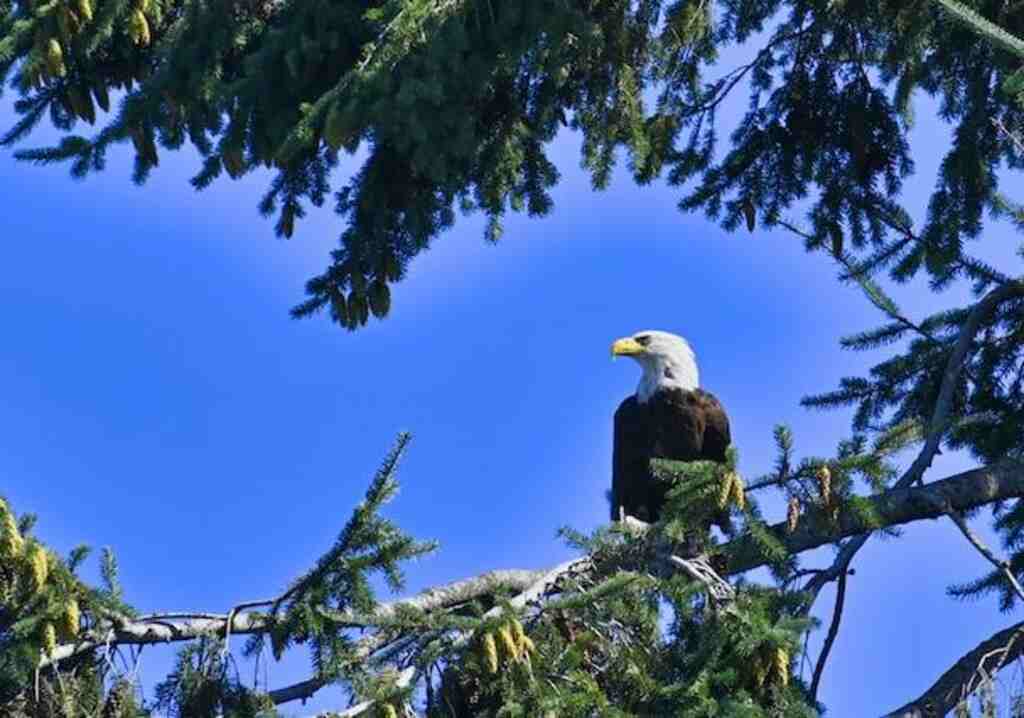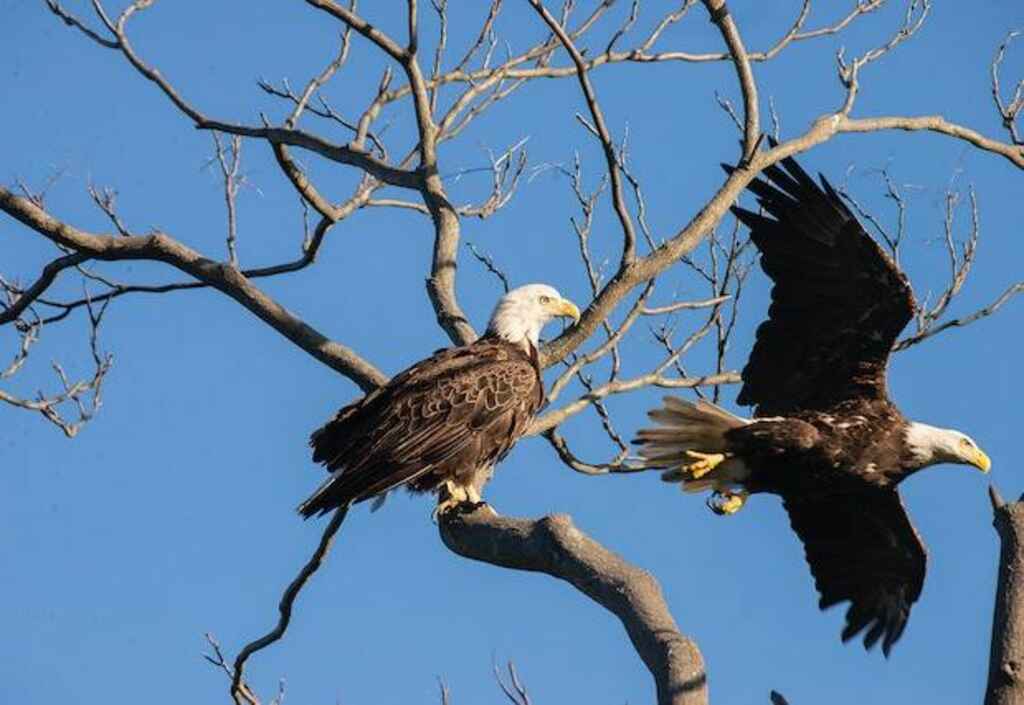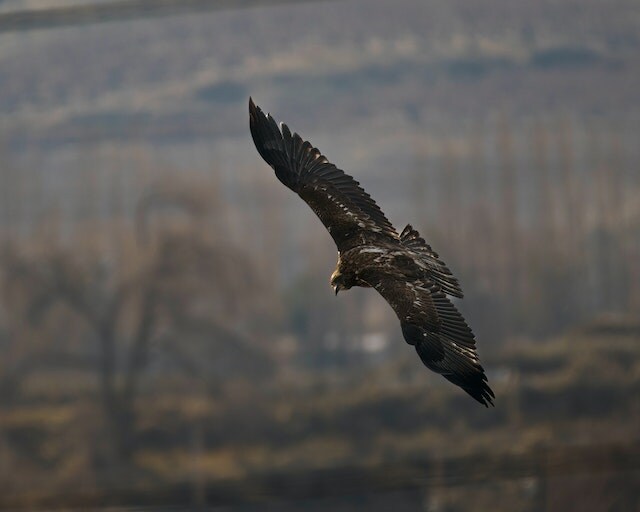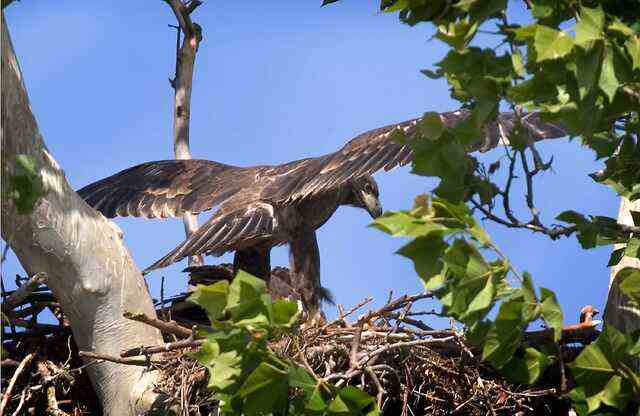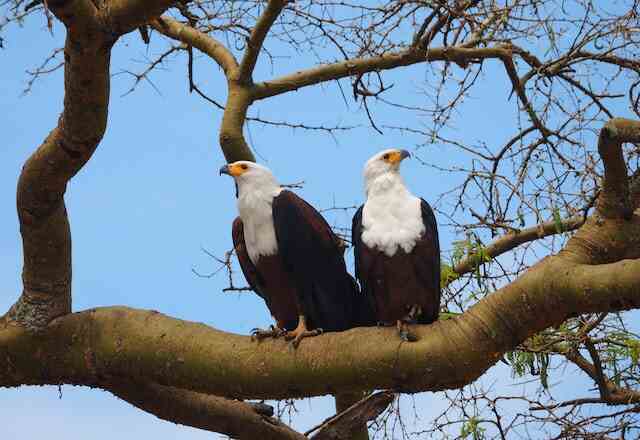Where Are Eagles Found? Unlocking the secrets of these majestic rulers of the skies is no easy feat.
While their presence spans far and wide, some eagle species remain masters of camouflage within forest hideouts, while others boldly grace open fields and waterways with their aerial prowess.
Delving into their whereabouts is crucial for conservation and eagle enthusiasts alike, revealing the hidden wonders of their natural habitats.
Get ready to embark on an extraordinary journey as we explore where eagles choose to roam.
Table of Contents
- 1 Key Takeaways
- 2 Brief Overview of Eagles
- 3 Where Are Eagles Found
- 4 Bald Eagles in North America
- 5 Golden Eagles in North America, Europe, and Asia
- 6 African Fish Eagles in Africa
- 7 Harpy Eagles in South and Central America
- 8 Martial Eagles in Africa
- 9 White-tailed Eagles in Europe and Asia
- 10 Steller’s Sea Eagles in Northeast Asia
- 11 Philippine Eagles in the Philippines
- 12 Australian Wedge-tailed Eagles in Australia
- 13 Frequently Asked Questions
- 13.1 How do eagles communicate with each other?
- 13.2 What is the lifespan of an eagle in captivity versus in the wild?
- 13.3 What is the significance of eagles in different cultures around the world?
- 13.4 What are some of the biggest threats to eagle populations today?
- 13.5 How do eagles hunt and what is their preferred prey?
- 14 Conclusion
- 15 Author
Key Takeaways
- Eagles are found on all continents except Antarctica and are adaptable to a variety of environments.
- They are large, powerful birds of prey with sharp talons and beaks used to catch and feed on other animals.
- Eagles are symbols of strength, freedom, and power in mythology and culture.
- Threats to their survival include habitat loss, hunting, and poisoning, but conservation efforts such as habitat protection and anti-poaching campaigns can help support their populations.
Brief Overview of Eagles
Eagles are large, powerful birds of prey that are distributed across all continents except for Antarctica.
These majestic birds have a wingspan that can range from six to eight feet and can weigh up to 15 pounds.
They are known for their sharp talons and beaks, which they use to catch and feed on other animals.
Eagle behavior is fascinating, as they are known to mate for life and usually build large nests that they return to each year.
Eagles in mythology and culture are often seen as symbols of strength, freedom, and power.
In Native American mythology, the eagle is seen as a messenger between the physical and spiritual worlds. In Ancient Greece, the eagle was associated with Zeus, the king of the gods.
Bald eagles in North America are a particular species of eagle that are known for their white heads and tails.
These magnificent birds are found mainly in North America, particularly near bodies of water where they can hunt for fish.
Where Are Eagles Found
Eagles are found worldwide, inhabiting diverse ecosystems across continents. They can be spotted in various regions, from the icy tundras of the North to the tropical rainforests of the South.
While some species prefer forested areas, others soar above open fields and waterways.
Understanding their habitats is vital for conservation and birdwatching enthusiasts aiming to witness these magnificent creatures in their natural environment.
Bald Eagles in North America
The majestic bird of prey known for its distinctive white head and powerful wingspan can be commonly observed soaring over the landscapes of North America.
The bald eagle, once on the brink of extinction, has made a remarkable recovery in recent decades.
According to a 2019 report by the U.S. Fish and Wildlife Service, the population of bald eagles in the lower 48 states has increased by more than 300% since 2009.
Bald eagles are known for their nesting behavior, often constructing their nests in tall trees near bodies of water. However, despite their impressive population growth, bald eagles still face threats to their survival.
Habitat loss, pollution, and the use of pesticides are among the major culprits.
Conservation efforts have been successful in mitigating some of these threats, but continued efforts are necessary to ensure the long-term survival of this iconic species.
As we shift our focus to golden eagles in North America, Europe, and Asia, it is important to recognize the ongoing challenges facing the bald eagle population and the importance of protecting this symbol of freedom and strength.
Golden Eagles in North America, Europe, and Asia
The Golden Eagles are found in North America, Europe, and Asia, favoring mountainous terrains and open landscapes.
They are known for their powerful hunting abilities and are apex predators that prey on small mammals, birds, and reptiles.
Despite being recognized as a species of ‘least concern’ by the IUCN, Golden Eagles in some regions face threats from habitat loss, hunting, and electrocution from power lines.
Location and Habitat
Located in various habitats around the world, eagles can be found in mountainous regions, forests, and even near bodies of water.
Here are four examples of eagle habitat and geographical distribution:
1) Bald eagles are commonly found near bodies of water such as lakes, rivers, and coastlines in North America.
2) The African fish eagle is found near freshwater lakes, rivers, and wetlands in sub-Saharan Africa.
3) The harpy eagle inhabits the rainforests of Central and South America.
4) The steppe eagle is found in grasslands and open country across Eurasia.
Eagles are known for their adaptability and can thrive in a variety of environments. Their ability to soar high above their habitat allows them to survey their surroundings and spot potential prey. With such a wide range of habitats, eagles have developed various hunting strategies to capture prey.
Diet and Hunting Habits
Dwelling in diverse habitats across the globe, these magnificent birds of prey have evolved unique hunting methods to successfully capture their prey, which is often larger than their own body size.
Eagles are known for their sharp talons and powerful beaks, which enable them to grasp and tear apart their prey with ease.
Their diet consists of various types of prey, including fish, small mammals, reptiles, and birds.
Eagles are also known for their impressive hunting techniques, such as soaring high in the sky and then diving at incredible speeds to catch their prey.
Their food sources and hunting techniques vary depending on their location and habitat. Eagles are also territorial birds and mate for life.
They build large nests in high locations, such as trees or cliffs, and defend their nesting territories fiercely.
Some species of eagles are also known for their migration patterns, traveling thousands of miles each year in search of food and nesting sites.
However, population trends for some species of eagles are declining due to habitat loss and human interference.
The ecological impact of these declines can have significant consequences for their respective ecosystems.
Eagles also hold cultural significance in many societies, representing courage, strength, and freedom.
In the next section, we will explore the conservation status of eagles and the efforts being made to protect these majestic birds.
Conservation Status
As fascinating as the hunting habits and diet of eagles may be, it is crucial to acknowledge their conservation status.
The eagle population has been under threat due to habitat loss, hunting, and poisoning.
To ensure their survival, various conservation efforts have been put in place, including habitat protection, research initiatives, and community involvement.
These efforts aim to protect the eagle population from further decline and promote its growth.
It is essential to take action to preserve these magnificent creatures and maintain their place in the ecosystem.
With that said, it is crucial to delve deeper into the African fish eagles in Africa.
African Fish Eagles in Africa
The African Fish Eagle is a majestic bird of prey commonly found in the rivers and lakes of Africa, known for its distinctive brown and white plumage and piercing call.
These eagles exhibit fascinating behavior and characteristics such as their ability to catch fish in mid-air, their monogamous pair bonding, and their territorial defense of nesting sites.
However, African Fish Eagles face threats to their populations, including habitat loss and degradation, poisoning from pesticides, and human disturbance.
Despite these challenges, conservation efforts are being made to protect these magnificent birds.
Moving on to the next section, the Harpy Eagles in South and Central America are also fascinating birds of prey with unique characteristics and behaviors.
Harpy Eagles in South and Central America
Native to the forests of South and Central America, the Harpy Eagle is an impressive bird of prey with a wingspan of up to seven feet.
Known for their striking appearance, these eagles have a distinctive crown of feathers on their heads and large, powerful talons that enable them to hunt for prey such as monkeys and sloths.
Despite being one of the largest and most powerful eagles in the world, Harpy Eagles are facing threats to their survival due to habitat loss and hunting.
Conservation efforts are being made to protect these majestic birds, including the establishment of protected areas and captive breeding programs.
The Harpy Eagle population in South America has been steadily increasing in recent years, thanks in part to these conservation efforts.
However, continued efforts are needed to ensure that these eagles continue to thrive in their natural habitats.
Moving on to the next subtopic, the Martial Eagle is another impressive bird of prey found in Africa.
Martial Eagles in Africa
Indigenous to the African continent, the Martial Eagle is a formidable raptor known for its impressive size and powerful hunting abilities.
These eagles are often found in savanna and grassland habitats, preferring areas with open spaces that allow them to soar and hunt for prey.
They are skilled hunters, preying on a variety of animals including small mammals, birds, and reptiles.
Martial Eagles are known for their breeding patterns, which typically occur during the dry season.
They often build their nests in tall trees or on rocky outcrops, and females lay one to two eggs at a time. Young eagles are raised in the nest for several months before fledging and becoming independent.
Despite their impressive size, Martial Eagles face threats from habitat loss and hunting, and conservation efforts are vital to their survival.
As we move to the next subtopic, we will explore the habitat preferences and behavior of white-tailed eagles in Europe and Asia.
White-tailed Eagles in Europe and Asia
Prevalent across Europe and Asia, the white-tailed eagle is a majestic bird of prey, known for its sharp vision and agile hunting skills. As a top predator, it plays an important role in maintaining ecological balance and biodiversity in its habitat.
However, due to habitat loss, hunting, and pollution, this species has faced significant decline in recent decades.
Efforts to conserve and protect the white-tailed eagle have been implemented through various measures such as habitat restoration, anti-poaching campaigns, and monitoring programs.
Additionally, the migration patterns of white-tailed eagles have been studied to better understand their behavior and needs, which has allowed for more effective conservation strategies.
Despite these efforts, continued vigilance is necessary to ensure the survival of this iconic species.
Moving forward, understanding the conservation needs of the white-tailed eagle will be crucial for protecting its populations.
This includes addressing threats such as climate change and habitat fragmentation, and working to establish sustainable practices that support both the eagle and the ecosystems it inhabits.
The importance of this work cannot be overstated, as the white-tailed eagle serves as a symbol of freedom and natural beauty for people around the world.
As we turn our attention to the next subsection, we will explore the unique characteristics and geographic range of the steller’s sea eagle in northeast Asia.
Steller’s Sea Eagles in Northeast Asia
Endemic to the coastal areas of northeastern Asia, the Steller’s sea eagle is a large and distinctive bird of prey known for its impressive size and striking appearance. With a wingspan of up to 2.5 meters, it is one of the largest eagles in the world.
The species is primarily found in the northeast Asian habitat, including Russia, Japan, and Korea.
Steller’s sea eagles feed mainly on fish, such as salmon, herring, and flounder, which are abundant in their coastal environment. They are also known to hunt seabirds and small mammals.
Due to their dependence on fish, Steller’s sea eagles are particularly vulnerable to changes in their habitat and prey availability.
In recent decades, their populations have declined due to habitat destruction, hunting, and pollution.
With only a few thousand individuals remaining, the Steller’s sea eagle is considered a threatened species.
The next section will focus on the Philippine eagles in the Philippines, another remarkable species of eagle that faces similar challenges to its survival.
Philippine Eagles in the Philippines
The Philippine eagle, also known as the monkey-eating eagle, is a critically endangered species of raptor with a unique appearance and behavior that can only be found in the Philippine archipelago.
The eagle has a striking appearance with its long, broad wings, a shaggy crest of feathers, and piercing eyes.
The bird’s diet consists mainly of monkeys, flying squirrels, and other small mammals.
Conservation efforts have been implemented to prevent the extinction of this species, including breeding programs, habitat protection, and education campaigns.
Despite these efforts, the Philippine eagle remains endangered, primarily due to habitat loss and hunting.
The future of this majestic bird relies heavily on the continued efforts of conservationists and the support of the public. Moving on to the next topic, the Australian Wedge-tailed Eagles in Australia.
Australian Wedge-tailed Eagles in Australia
Moving away from the Philippine Eagles, another fascinating bird of prey, the Australian Wedge-tailed Eagle, is a majestic sight to behold in its native land.
This eagle species is endemic to Australia and is known for its impressive size, with a wingspan that can reach up to 2.5 meters.
Australian Wedge-tailed Eagles can be found throughout the continent, from tropical rainforests to arid deserts.
These eagles have unique breeding patterns and nesting behaviors that have been studied extensively by scientists.
They typically mate for life and build large nests in the tallest trees, where they lay one to two eggs per year.
The eaglets stay in the nest for up to three months before they fledge and leave the nest.
Overall, the Australian Wedge-tailed Eagle is an impressive bird of prey that has adapted well to the diverse range of habitats throughout Australia.
| Philippine Eagles | Australian Wedge-tailed Eagles | |
|---|---|---|
| Size | Smaller | Larger |
| Range | Philippines | Australia |
| Nesting Behaviors | Solitary nesters | Build large nests in tall trees |
| Breeding Patterns | Mate for life | Lay 1-2 eggs per year |
Frequently Asked Questions
How do eagles communicate with each other?
Eagles communicate with each other through a range of vocalizations and body language. Vocalizations include screams, whistles, and chirps, while body language involves posturing, wing displays, and tail movements. These methods help eagles communicate their intentions and establish dominance within their social hierarchy.
What is the lifespan of an eagle in captivity versus in the wild?
Comparing the diets of eagles, their lifespan in captivity is generally longer than in the wild. However, this varies among different bird species. Studies show that the lifespan of birds in captivity is influenced by factors such as diet and environment.
What is the significance of eagles in different cultures around the world?
Eagle symbolism varies across cultures, representing strength, freedom, and power. Eagle conservation efforts are important due to their ecological significance and cultural significance. Understanding their role in different societies can aid in preservation efforts.
What are some of the biggest threats to eagle populations today?
Poaching and habitat loss are two major threats to eagle populations today. Poaching occurs for their feathers and body parts while habitat loss due to human activities leaves eagles with fewer places to live and hunt.
How do eagles hunt and what is their preferred prey?
Eagle hunting techniques vary based on species and habitat, but they generally rely on keen eyesight and powerful aerial attacks. Their dietary preferences range from fish and small mammals to birds and reptiles, depending on availability.
Conclusion
In conclusion, eagles are magnificent birds of prey that inhabit different regions of the world.
Bald eagles, the national bird of the United States, are found in North America, while golden eagles are found in North America, Europe, and Asia.
African fish eagles thrive in Africa, while harpy eagles are found in South and Central America.
White-tailed eagles inhabit Europe and Asia, while Steller’s sea eagles are native to Northeast Asia.
The Philippine eagle, one of the largest eagles in the world, can be found in the Philippines, and the Australian wedge-tailed eagle is a prominent bird of prey in Australia.
Eagles are known for their keen eyesight, powerful talons, and graceful flight.
They are apex predators and play an important ecological role in maintaining the balance of their respective ecosystems.
Their ability to soar through the air with ease and precision is likened to that of a skilled athlete performing a routine.
Studying eagles and their habitats can provide valuable insights into the health and well-being of our planet’s diverse ecosystems.

